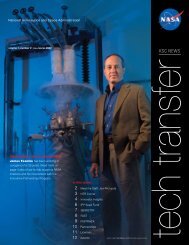2006-2007 - Kennedy Space Center Technology Transfer Office
2006-2007 - Kennedy Space Center Technology Transfer Office
2006-2007 - Kennedy Space Center Technology Transfer Office
- No tags were found...
Create successful ePaper yourself
Turn your PDF publications into a flip-book with our unique Google optimized e-Paper software.
Mean relative percentage change in elemental concentration compared with starting sample forApollo 14163 lunar regolith, using aluminum charger (particle size = 50 to 75 μm).Sample Na Fe O Ti Ca C Si AlPositive plate 23 15 8 70 –* –20 8 –*Negative plate 7 –8 –10 –20 –7 7 –* –*Unseparated –* 31 16 210 21 –44 15 17* Relative changes are within error.Positive PlateNegative Plate1.01.00.50.50.00.01.01.00.50.50.00.01.01.00.50.50.0500 1,0000.0500 1,000Raman Shift (cm –1 ) Raman Shift (cm –1 )Figure 2. Raman spectra of beneficiated Apollo 14 samples, using an aluminum tribocharger.Raman spectroscopy was performed for the purpose of characterizing the mineralogy of the samplesbefore and after beneficiation. The Raman data (Figure 2) shows the difference in spectra between thedifferent beneficiated fractions that result from the different mineral compositions. The positive plateis composed mostly of plagioclase. A few extra minerals are present, but their corresponding peaksare of low intensity. The negative plate is a mixture of solid solution a Fe 2O 3/FeTiO 3(226 cm –1 ),Pseudobrookite – FeTiO 5(323 cm –1 ), plagioclase, ilmenite (FeTiO 3), and pyroxene (997, 1,000 cm –1 ).The newly designed tribocharging setup successfully charged and separated JSC-1 lunar simulantand Apollo 14 lunar soil. It also provided preliminary data indicating enrichment of iron- andtitanium-rich minerals in a vacuum. This technique may prove to be a viable tool for specific mineralenrichment of regolith prior to oxygen production processing or other structural-material processing.Future work will focus on optimizing the length of the tribocharger and the charge separator, as well aspossible integration into the In Situ Resource Utilization project’s engineering breadboard unit.Contacts: Dr. Jacqueline W. Quinn , NASA-KSC, (321) 867-8410; and Dr. SteveTrigwell , ASRC Aerospace, (321) 867-1222Participating Organizations: University of Central Florida (James G. Captain); University of Arkansas (Dr. Alex S.Biris); and NASA-KSC (Dr. Carlos I. Calle, Ellen E. Arens, and Dr. Janine E. Captain)KSC <strong>Technology</strong> Development and Application <strong>2006</strong>-<strong>2007</strong>39













